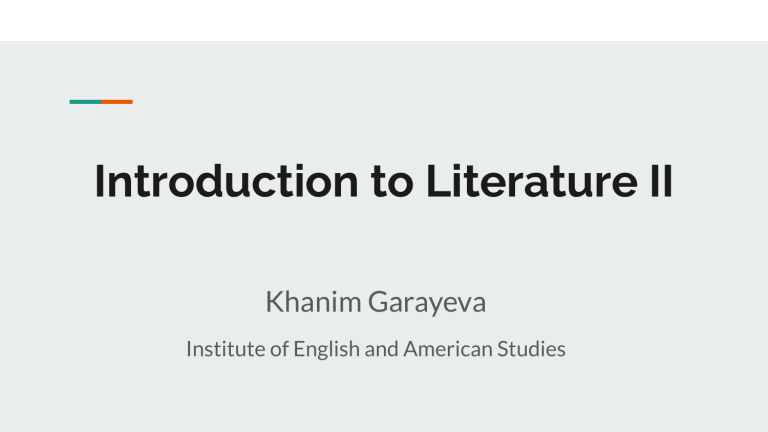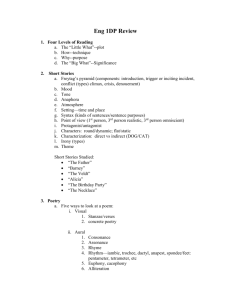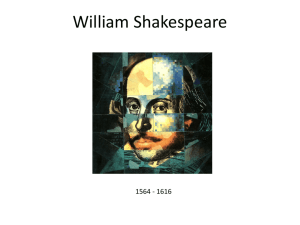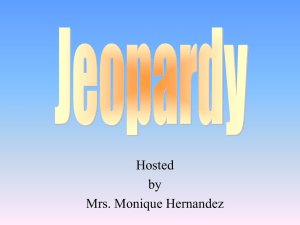
Introduction to Literature II Khanim Garayeva Institute of English and American Studies Study Materials Primary Readings: ● ● A Reader Separate PDF files Theoretical Readings: ● ● Pope, Rob. 2002. The English Studies Book. 2nd edition. Routledge. Selden, R., Widdowson P. and Brooker, P. 2005. A Reader’s Guide to Contemporary Literary Theory. 5th edition. Pearson Longman. Requirements a/ Term paper - 5 pages’ interpretative, argumentative paper on any of the assigned readings using one or more of the studied approaches. For references use footnotes and add a “List of References” - 40% b/ Term test – 40% c/ Active, verbal participation (simply being present does not count) – 20% d/ More than 3 absences, particularly at final test, and plagiarism will automatically result in failure. What is Literature? Literature is without one commonly accepted definition. Generally: a collection of written texts in different forms like books, diaries, memoirs, essays, poems, novels, autobiographies, letters, etc. Precisely: a collection of writings especially in prose, drama and poetry. It appears that literature (or literariness) is not something that exists objectively as a piece of empirical reality that we will recognize any time in any situation. Various readers have very different reactions to the same text in different circumstances and different historical, social, cultural contexts. Texts Scientific: correspondence theory of truth conditions, i.e. a text is acceptable and true if its statement corresponds to the actual reality; Literary: the coherence theory of truth conditions, i.e. a text is acceptable and valid if it is coherent, that is, its statements do not contradict each-other. This is why literary texts often represent fictitious, made-up, invented stories or worlds: they represent a possible world which may be the actual world, but it can also be a fictitious world. Figures of Speech (part 1) Figures of Opposition: 1. Zeugma - one verb refers to two or more objects: “Or stain her honour, / or her new brocade.” 2. Antithesis - a statement followed by negation. "Willing to love / Yet afraid to kiss." 3. Oxymoron - bringing together two radically opposite elements: hot ice, heavy lightness, bright darkness, joyful sorrow. 4. Paradox - longer oxymoron, very common in the Bible: “He that would save his life must lose it; and he that would lose his life will save it.” Figures of Speech (part 2) Figures of Irony: 1. 2. Litotes - negating the opposite of what you want to say: "not too old, not a bad idea. It's not the best weather today (hurricane)." Irony - the opposite meaning is intended indirectly: "Arnold Schwarzenegger has been the most talented and best governor in the history of the USA." Figures of Naming: 1. 2. 3. Apostrophe - direct addressing of something or somebody: "Thou still unravish’d bride of quietness!” Hyperbole - deliberate exaggeration: "My birthday cake was larger than your car! TIK is so big that we can seat an entire army in it!" Allusion - an indirect reference to a well-known cultural item, person, event, etc.: " If I'm not home by midnight, my car might turn into a pumpkin. Bring me an apple, but not the one from the serpent!" William Shakespeare (1564 - 1616) ● ● ● A poet, playwright and actor of the Renaissance era; Created the Globe Theatre; Author of: ○ 154 sonnets; ○ 39 plays - comedies, tragedies and tragicomedies; ○ 2 long narrative poems, etc.; Photo: biography.com What is a Sonnet? ● ● ● ● ● ● Derived from the Italian word "sonetto" meaning a little poem; Dates back to the 13th century Sicilian school of poets; Has a strict rhyme scheme and structure; Writers of sonnets are called "sonneteers"; Shakespeare's sonnets are in iambic pentameter: ○ Iambic - a group of unstressed syllables followed by stressed syllables a "foot". ○ Pentameter - a line of 5 "feet". ○ Each line usually has 10 syllables; Sonnets are in 14 lines, meaning 8 (octave) + 6 (sestet) lines' rhyme. Next Class: Feb. 17th. Structural Elements, Genres. What is poetry? The Formalist Approach: Jakobson’s model of communication - Authorial intention and meaning creation. Raman Selden: A Reader’s Guide to Contemporary Literary Theory, pp. 30-39. Jakobson’s model of communication - (pdf on CooSpace) SHAKESPEARE, “Devouring Time” – 19th Sonnet (A Reader) E.E. CUMMINGS, “anyone lived in a pretty how town” (1940), (pdf on CooSpace)




